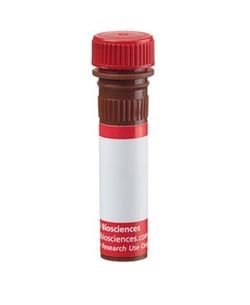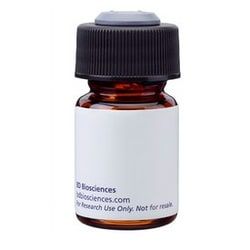BDB558710
PARP (Asp 214) Mouse, Alexa Fluor 647, Clone: F21-852, BD
Manufacturer: BD Biosciences
Select a Size
| Pack Size | SKU | Availability | Price |
|---|---|---|---|
| Each of 1 | BDB558710-Each-of-1 | In Stock | ₹ 46,146.50 |
BDB558710 - Each of 1
In Stock
Quantity
1
Base Price: ₹ 46,146.50
GST (18%): ₹ 8,306.37
Total Price: ₹ 54,452.87
Antigen
PARP (Asp 214)
Classification
Monoclonal
Conjugate
Alexa Fluor 647
Formulation
Aqueous buffered solution containing BSA, protein stabilizer, and ≤0.09% sodium azide.
Immunogen
Human cleaved PARP
Quantity
100 Tests
Research Discipline
Cell Biology
Target Species
Human, Mouse
Isotype
IgG1 κ
Applications
Flow Cytometry
Clone
F21-852
Description
Asp214
Host Species
Mouse
Purification Method
Affinity Purified
Regulatory Status
RUO
Primary or Secondary
Primary
Content And Storage
Store undiluted at 4°C and protected from prolonged exposure to light. Do not freeze.
Description
- PARP (Poly (ADP-Ribose) Polymerase) is a 113kDa nuclear chromatin-associated enzyme that catalyzes the transfer of ADP-ribose units from NAD+ to a variety of nuclear proteins including topoisomerases, histones, and PARP itself
- The catalytic activity of PARP is increased in cells following DNA damage, and PARP is thought to play an important role in mediating the normal cellular response to DNA damage
- Additionally, PARP is a target of the caspase protease activity associated with apoptosis
- The PARP protein consists of an N-terminal DNA-binding domain (DBD) and a C-terminal catalytic domain separated by a central automodification domain
- During apoptosis, Caspase-3 cleaves PARP at a recognition site (Asp Glu Val Asp Gly) in the DBD to form 24- and 89kDa fragments
- This process separates the DBD (which is mostly in the 24kDa fragment) from the catalytic domain (in the 89kDa fragment) of the enzyme, resulting in the loss of normal PARP function
- It has been proposed that inactivation of PARP directs DNA-damaged cells to undergo apoptosis rather than necrotic degradation, and the presence of the 89kDa PARP cleavage fraction is considered to be a marker of apoptosis
- A peptide corresponding to the N-terminus of the cleavage site (Asp 214) of human PARP was used as the immunogen
- The F21-852 monoclonal antibody reacts only with the 89kDa fragment of human PARP-1 that is downstream of the Caspase-3 cleavage site (Asp214) and contains the automodification and catalytic domains
- It does not react with intact human PARP-1
- Cross-reactivity with other members of the PARP superfamily is unknown
- It may also recognize cleaved PARP in a number of other species due to the conserved nature of the molecule, although this has not been tested at BD Biosciences Pharmingen
- Bioimaging
Compare Similar Items
Show Difference
Antigen: PARP (Asp 214)
Classification: Monoclonal
Conjugate: Alexa Fluor 647
Formulation: Aqueous buffered solution containing BSA, protein stabilizer, and ≤0.09% sodium azide.
Immunogen: Human cleaved PARP
Quantity: 100 Tests
Research Discipline: Cell Biology
Target Species: Human, Mouse
Isotype: IgG1 κ
Applications: Flow Cytometry
Clone: F21-852
Description: Asp214
Host Species: Mouse
Purification Method: Affinity Purified
Regulatory Status: RUO
Primary or Secondary: Primary
Content And Storage: Store undiluted at 4°C and protected from prolonged exposure to light. Do not freeze.
Antigen:
PARP (Asp 214)
Classification:
Monoclonal
Conjugate:
Alexa Fluor 647
Formulation:
Aqueous buffered solution containing BSA, protein stabilizer, and ≤0.09% sodium azide.
Immunogen:
Human cleaved PARP
Quantity:
100 Tests
Research Discipline:
Cell Biology
Target Species:
Human, Mouse
Isotype:
IgG1 κ
Applications:
Flow Cytometry
Clone:
F21-852
Description:
Asp214
Host Species:
Mouse
Purification Method:
Affinity Purified
Regulatory Status:
RUO
Primary or Secondary:
Primary
Content And Storage:
Store undiluted at 4°C and protected from prolonged exposure to light. Do not freeze.
Antigen: __
Classification: __
Conjugate: Alexa Fluor 647
Formulation: __
Immunogen: __
Quantity: 50 Tests
Research Discipline: __
Target Species: __
Isotype: IgG2b κ
Applications: Flow Cytometry
Clone: 27-35
Description: __
Host Species: Mouse
Purification Method: Affinity Purified
Regulatory Status: __
Primary or Secondary: __
Content And Storage: Undiluted at 4°C
Antigen:
__
Classification:
__
Conjugate:
Alexa Fluor 647
Formulation:
__
Immunogen:
__
Quantity:
50 Tests
Research Discipline:
__
Target Species:
__
Isotype:
IgG2b κ
Applications:
Flow Cytometry
Clone:
27-35
Description:
__
Host Species:
Mouse
Purification Method:
Affinity Purified
Regulatory Status:
__
Primary or Secondary:
__
Content And Storage:
Undiluted at 4°C
Antigen: CD123
Classification: Monoclonal
Conjugate: PerCP-Cyanine5.5
Formulation: Aqueous buffered solution containing BSA and ≤0.09% sodium azide.
Immunogen: Human IL-3Ra-transfected cells
Quantity: 100 Tests
Research Discipline: Immunology
Target Species: Human
Isotype: IgG2a κ
Applications: Flow Cytometry
Clone: 7G3
Description: IL3RA; IL-3RA; IL-3Rα; IL-3R-alpha; Interleukin-3 receptor subunit alpha
Host Species: Mouse
Purification Method: __
Regulatory Status: RUO
Primary or Secondary: Primary
Content And Storage: Store undiluted at 4°C and protected from prolonged exposure to light. Do not freeze.
Antigen:
CD123
Classification:
Monoclonal
Conjugate:
PerCP-Cyanine5.5
Formulation:
Aqueous buffered solution containing BSA and ≤0.09% sodium azide.
Immunogen:
Human IL-3Ra-transfected cells
Quantity:
100 Tests
Research Discipline:
Immunology
Target Species:
Human
Isotype:
IgG2a κ
Applications:
Flow Cytometry
Clone:
7G3
Description:
IL3RA; IL-3RA; IL-3Rα; IL-3R-alpha; Interleukin-3 receptor subunit alpha
Host Species:
Mouse
Purification Method:
__
Regulatory Status:
RUO
Primary or Secondary:
Primary
Content And Storage:
Store undiluted at 4°C and protected from prolonged exposure to light. Do not freeze.
Antigen: CD8a
Classification: Monoclonal
Conjugate: Unconjugated
Formulation: Aqueous buffered solution containing ≤0.09% sodium azide.
Immunogen: Mouse thymus / spleen
Quantity: 0.1 mg
Research Discipline: Immunology
Target Species: Mouse
Isotype: IgG2a κ
Applications: Flow Cytometry
Clone: 53-6.7
Description: Cd8a; CD8 alpha chain; Ly-2; Lyt2; Lyt-2; Ly-35; Ly-B
Host Species: Rat
Purification Method: Affinity Purified
Regulatory Status: RUO
Primary or Secondary: Primary
Content And Storage: Store undiluted at 4°C
Antigen:
CD8a
Classification:
Monoclonal
Conjugate:
Unconjugated
Formulation:
Aqueous buffered solution containing ≤0.09% sodium azide.
Immunogen:
Mouse thymus / spleen
Quantity:
0.1 mg
Research Discipline:
Immunology
Target Species:
Mouse
Isotype:
IgG2a κ
Applications:
Flow Cytometry
Clone:
53-6.7
Description:
Cd8a; CD8 alpha chain; Ly-2; Lyt2; Lyt-2; Ly-35; Ly-B
Host Species:
Rat
Purification Method:
Affinity Purified
Regulatory Status:
RUO
Primary or Secondary:
Primary
Content And Storage:
Store undiluted at 4°C



